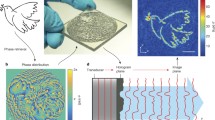Abstract
For the purpose of ultrasonic nondestructive testing of materials, holography in connection with digital reconstruction algorithms has been proposed as a modern tool to extract crack sizes from ultrasonic scattering data. Defining the typical holographic reconstruction algorithm as the application of the scalar Kirchhoff diffraction theory to backward wave propagation, we demonstrate its general incapability of reconstructing equivalent sources, and hence, geometries of scattering bodies. Only the special case of a planar measurement recording surface, that is to say, a hologram plane, and a planar crack with perfectly rigid boundary conditions parallel to the hologram plane and perpendicular to the incident field yields a nearly perfect correlation between crack size and reconstructed image; the reconstruction algorithm is then referred to as the Rayleigh-Sommerfeld formula; it therefore represents the optimal case matched to that special geometrical situation and, hence, may be interpreted as a quasi-matched spatial filter. Using integral equation theory and physical optics, we compute synthetic holographic data for a linear cracklike scatterer for both plane and spherical wave incidence, the latter case simulating a synthetic aperture impulse echo situation, thus illustrating how the Rayleigh-Sommerfeld algorithm or its Fresnel approximation increasingly fail for cracks inclined to the hologram plane and excited nonperpendicularly. Furthermore, we point out how the physical data recording process may additionally influence the reconstruction accuracy, and, finally, guidelines for a careful and serious application of these holographic reconstruction algorithms are given. The theoretical results are supported by measurements.
Similar content being viewed by others
References
D. O. Thompson, Purpose and progress of quantitative NDE. Proc. ARPA/AFML Review of Progress in Quantitative NDE, La Jolla, Calif. (1979).
Y. Aoki, Optical and numerical reconstructions of images from sound-wave holograms.IEEE Trans. Audio Electroacoustics AU-18:258 (1970).
J. Kutzner and H. Wüstenberg, Akustische Linienholographie, ein Hilfsmittel zur Fehleranzeigeninterpretation in der Ultraschallprüfung.Material-prüfung 18:189 (1976).
J. P. Powers and D. E. Müller, A computerized acoustic imaging technique incorporating automatic object recognition, inAcoustical Holography, Vol. 5, Ph. S. Green, ed. (Plenum Press, New York, 1973).
B. P. Hildebrand and B. B. Brenden,An Introduction to Acoustical Holography (Plenum Press, New York, 1972).
J. Kutzner and J. Zimpfer, Einsatz der akustischen Holographie zur Erzeugung von Schattenbildern in der Ultraschallprüfung.Materialprüfung 19:181 (1977).
V. Schmitz and M. Wosnitza, Experiences in using ultrasonic holography in the laboratory and in the field with optical and numerical reconstruction, inAcoustical Imaging, Vol. 8, A. F. Metherell, ed., (Plenum Press, New York, 1980).
W. R. Stone, Holographic reconstruction is usually a poor solution to the inverse scattering problem: a comparison between the Bojarski exact inverse scattering theory and holography as applied to the holographic radio camera. Proc. Int. Optical Computing Conf., Washington, D.C. (April 1980).
J. W. Goodman,Introduction to Fourier Optics (McGraw-Hill, San Francisco, 1968).
J. D. Gaskill,Linear Systems, Fourier Transforms and Optics (John Wiley & Sons, New York, 1978).
R. J. Collier, Ch. B. Burckhardt, and L. H. Liu,Optical Holography (Academic Press, New York, 1971).
C. W. Helmström,Statistical Theory of Signal Detection (Pergamon Press, Oxford, 1968).
R. W. T. Bates and G. C. McKinnon, Possible application of inverse scattering concepts to ultrasonic imaging, inResearch Techniques in Nondestructive Testing, Vol. IV. R. S. Sharpe, ed. (Academic Press, London, 1980).
N. N. Bojarski, Exact inverse scattering theory. Report prepared for and supported by the Office of Naval Research, Arlington, Va., under Contract No. N00014-76-C-0082 (March 1980).
A. Sommerfeld,Optik. Vorlesungen über Theoretische Physik, Bd. IV (Akademische Verlagsgesellschaft, Leipzig, 1964).
J. J. Bowman, T. B. A. Senior, and P. L. E. Uslenghi,Electromagnetic and Acoustic Scattering by Simple Shapes (North-Holland, Amsterdam, 1969).
A. Erdélyi, W. Magnus, F. Oberhettinger, and F. G. Tricomi,Tables of Integral Transforms (McGraw-Hill, New York, 1954).
R. Harrington,Scattering by Moment Methods (Macmillan, New York, 1968).
J. L. Pfeifer, Acoustical reconstruction of holograms and their potential use, inAcoustical Holography, Vol. 4, G. Wade, ed. (Plenum Press, New York, 1972).
A. Papoulis,Signal Analysis (McGraw-Hill, New York, 1977).
J. Kutzner, H. Wüstenberg, and A. Erhard, Beitrag zur Problematik der numerischen Rekonstruktion von Ultraschallhologrammen in zerstörungsfreier Materialprüfung.Materialprüfung 22:295 (1980).
R. W. Hamming,Digital Filters (Prentice-Hall, Englewood Cliffs, N.J., 1977).
N. N. Bojarski, Electromagnetic inverse scattering, inNASA Technical Memorandum “Mathematics of Profile Inversion” L. Colin, ed. (NASA TM-X-62, Moffet Field, Calif. 1972), p. 150.
N. Bleistein, Physical optics farfield inverse scattering in the time domain.J. Acoust. Soc. Am. 60:1249 (1976).
Author information
Authors and Affiliations
Rights and permissions
About this article
Cite this article
Berger, M., Brück, D., Fischer, M. et al. Potential and limits of holographic reconstruction algorithms. J Nondestruct Eval 2, 85–111 (1981). https://doi.org/10.1007/BF00566307
Received:
Issue Date:
DOI: https://doi.org/10.1007/BF00566307




